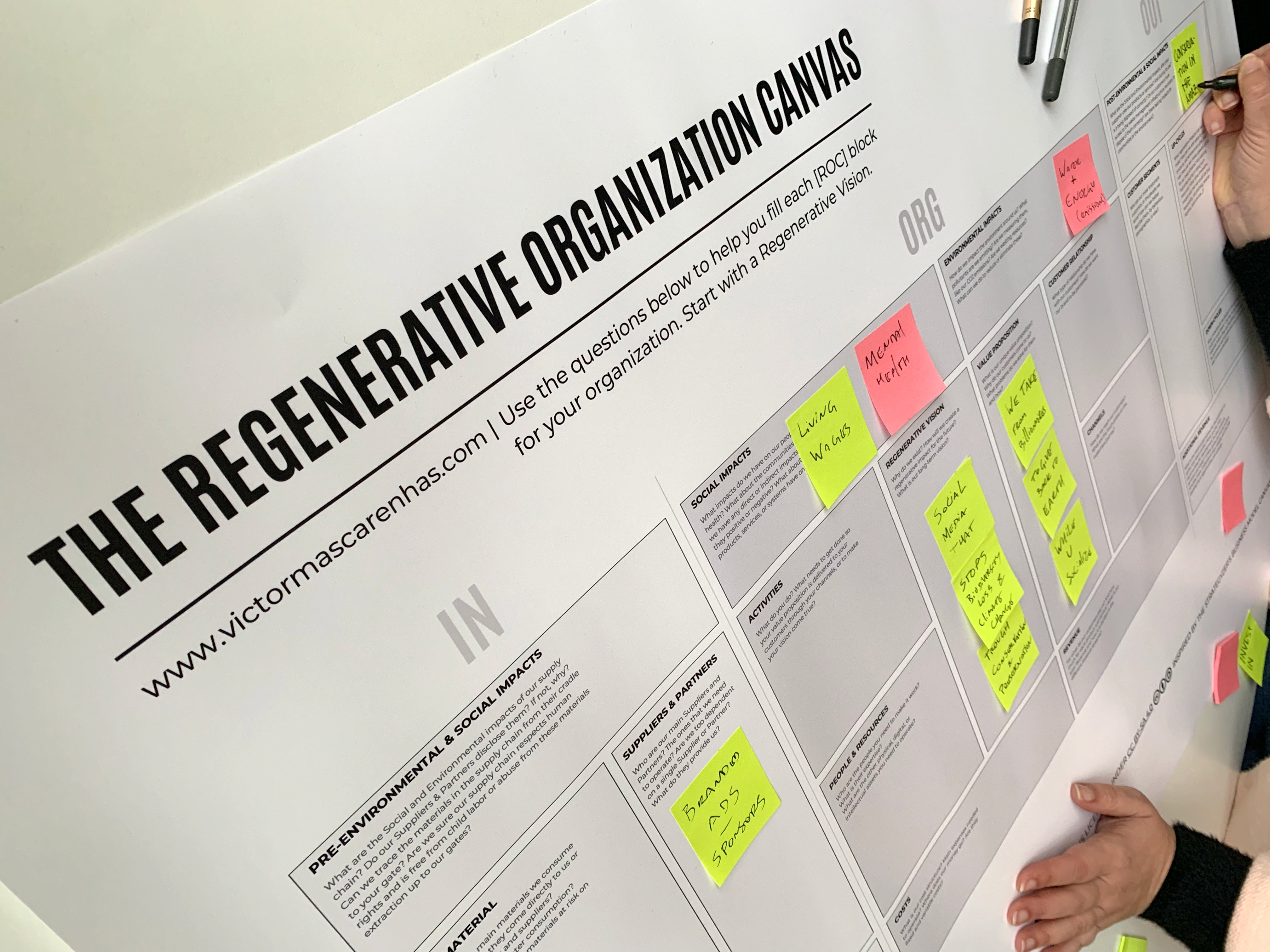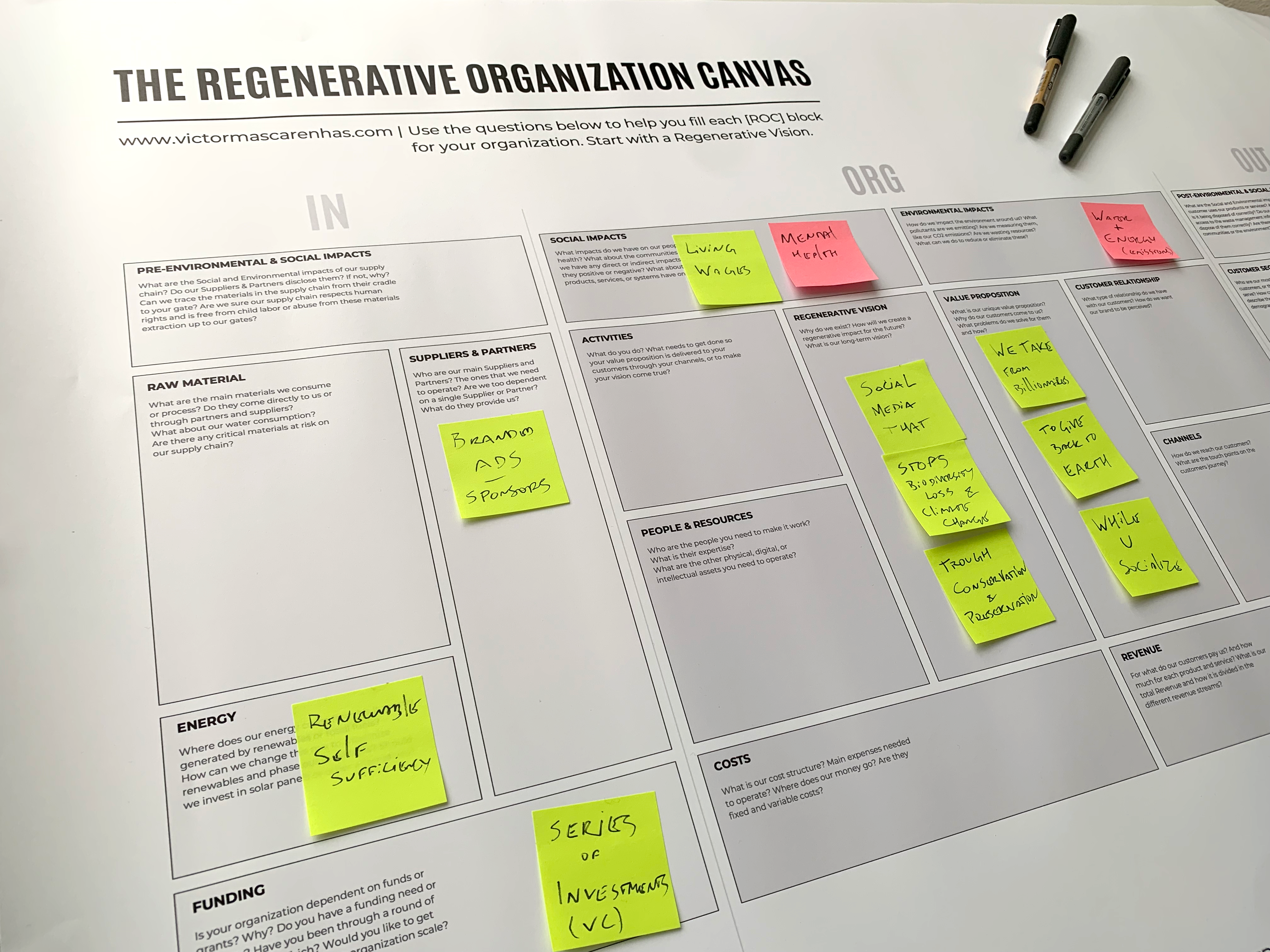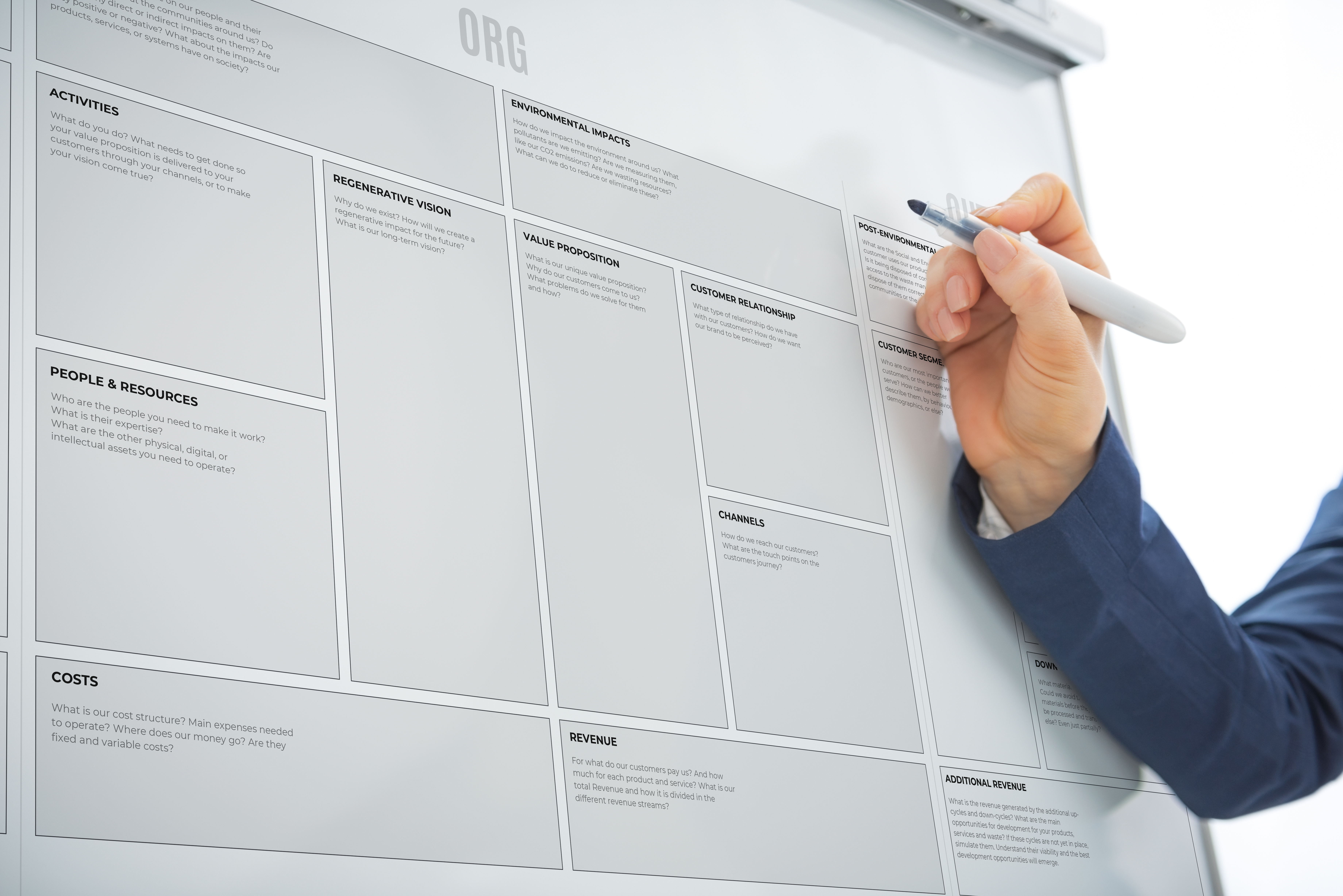Shaping a circular industrial ecosystem and supporting life-cycle thinking
[ROC]
Regenerative Organization Canvas
The [ROC] helps any organization move towards its Regenerative Future.
A framework that goes beyond the traditional Business Model Canvas and Business-as-Usual. Incorporating an Integral Sustainability approach to maximize positive environmental and social impacts for any type of organization, be it public, for profit, or non.
Designed to be accessible, and overcome jargon to foster regenerative innovation. Creating tangible results, and truly regenerative ecosystems.
A framework that goes beyond the traditional Business Model Canvas and Business-as-Usual. Incorporating an Integral Sustainability approach to maximize positive environmental and social impacts for any type of organization, be it public, for profit, or non.
Designed to be accessible, and overcome jargon to foster regenerative innovation. Creating tangible results, and truly regenerative ecosystems.
Portugal
National
It addresses urban-rural linkages
It refers to other types of transformations (soft investment)
Yes
2024-07-22
No
No
No
As an individual
The Regenerative Organization Canvas [ROC] is a strategic framework that transforms traditional business models into regenerative systems. Moving beyond conventional sustainability, it helps organizations maximize positive impact through optimized resource flows and ecosystem relationships.
The framework is designed for a diverse range of professionals—from business leaders and executives to sustainability experts and ESG consultants—across public, private, and third sectors through four key mechanisms:
1. Resource Flow Mapping: Analyzes material, energy, and value flows to identify opportunities in waste streams
2. Life-cycle Integration: Converts linear processes into regenerative cycles through up-cycling and down-cycling
3. Ecosystem Development: Creates resilient supplier networks and collaborative value chains
4. Impact Optimization: Transforms sustainability challenges into business opportunities beyond zero-waste goals
[ROC] implementation delivers concrete outcomes: waste becomes revenue, resource costs decrease, and innovation emerges through new product development and business models. Organizations develop stronger stakeholder relationships and more resilient supply chains while generating measurable environmental and social impact.
Unlike traditional circular economy approaches, [ROC] emphasizes regenerative cycles over closed loops. It establishes a long-term regenerative vision that guides organizations through transformation, providing practical visualization tools and measurement mechanisms. This integrated approach demonstrates that regenerative practices can deliver both purpose and profit, creating lasting positive impact for communities and stakeholders.
The framework is designed for a diverse range of professionals—from business leaders and executives to sustainability experts and ESG consultants—across public, private, and third sectors through four key mechanisms:
1. Resource Flow Mapping: Analyzes material, energy, and value flows to identify opportunities in waste streams
2. Life-cycle Integration: Converts linear processes into regenerative cycles through up-cycling and down-cycling
3. Ecosystem Development: Creates resilient supplier networks and collaborative value chains
4. Impact Optimization: Transforms sustainability challenges into business opportunities beyond zero-waste goals
[ROC] implementation delivers concrete outcomes: waste becomes revenue, resource costs decrease, and innovation emerges through new product development and business models. Organizations develop stronger stakeholder relationships and more resilient supply chains while generating measurable environmental and social impact.
Unlike traditional circular economy approaches, [ROC] emphasizes regenerative cycles over closed loops. It establishes a long-term regenerative vision that guides organizations through transformation, providing practical visualization tools and measurement mechanisms. This integrated approach demonstrates that regenerative practices can deliver both purpose and profit, creating lasting positive impact for communities and stakeholders.
Regeneration
Innovation
Systemic
ESG
Transformation
The [ROC] demonstrates exemplary sustainability practices through its comprehensive approach to organizational transformation:
Systems Transformation: Transcends traditional sustainability by moving organizations from degenerative to regenerative models; Integrates environmental and social considerations into core business strategy, eliminating externalities; Creates measurable positive impact beyond zero-waste targets. Regenerative Innovation: Transforms "waste" into value through circular resource flows; Extends product lifecycles through up-cycling and down-cycling; Reduces resource consumption while generating new revenue streams. Ecosystem Resilience: Builds regenerative supply chains and partnerships; Creates collaborative value networks; Strengthens local communities and stakeholder relationships
The [ROC] stands out as exemplary in the sustainability field for several reasons:
Holistic Integration: Rather than treating sustainability as an add-on, ROC embeds regenerative thinking into every aspect of organizational operations. This comprehensive approach ensures lasting transformation. Practical Implementation: By providing clear visualization tools and measurement mechanisms, ROC makes regenerative transformation accessible and actionable for organizations of all types and sizes. Future-Focused Design: The framework's focus on a long-term regenerative vision and on regenerative cycles rather than just closed loops, positions organizations to create positive impact for future generations while maintaining current business viability. Overcoming short-termism and profit maximization to foster regenerative impact.
The [ROC] exemplifies next-generation sustainability by proving that organizations can go beyond profits, to enhance ecological systems, and create social value. Its success in achieving these objectives demonstrates that regenerative business models are not utopian or aspirational but practically achievable.
Systems Transformation: Transcends traditional sustainability by moving organizations from degenerative to regenerative models; Integrates environmental and social considerations into core business strategy, eliminating externalities; Creates measurable positive impact beyond zero-waste targets. Regenerative Innovation: Transforms "waste" into value through circular resource flows; Extends product lifecycles through up-cycling and down-cycling; Reduces resource consumption while generating new revenue streams. Ecosystem Resilience: Builds regenerative supply chains and partnerships; Creates collaborative value networks; Strengthens local communities and stakeholder relationships
The [ROC] stands out as exemplary in the sustainability field for several reasons:
Holistic Integration: Rather than treating sustainability as an add-on, ROC embeds regenerative thinking into every aspect of organizational operations. This comprehensive approach ensures lasting transformation. Practical Implementation: By providing clear visualization tools and measurement mechanisms, ROC makes regenerative transformation accessible and actionable for organizations of all types and sizes. Future-Focused Design: The framework's focus on a long-term regenerative vision and on regenerative cycles rather than just closed loops, positions organizations to create positive impact for future generations while maintaining current business viability. Overcoming short-termism and profit maximization to foster regenerative impact.
The [ROC] exemplifies next-generation sustainability by proving that organizations can go beyond profits, to enhance ecological systems, and create social value. Its success in achieving these objectives demonstrates that regenerative business models are not utopian or aspirational but practically achievable.
Key Design and Cultural Objectives of the [ROC]:
1. Visual Clarity and Accessibility
. Transforms complex sustainability data into one intuitive visualization
. Makes regenerative thinking accessible to all organizational levels
. Simplifies decision-making through clear visual frameworks
2. User Experience
. Streamlines sustainability reporting into a single, comprehensive canvas
. Integrates multiple frameworks (ESG, CSRD, LCA) into one cohesive tool
. Provides an engaging, intuitive interface for strategic planning
3. Cultural Transformation
. Shifts organizational mindset from compliance to innovation
. Empowers decision-makers to think beyond zero-sum sustainability
. Creates a shared language for regenerative practices
The [ROC] revolutionizes how organizations engage with sustainability, similar to how the Business Model Canvas transformed business planning. Instead of navigating through thousand-page sustainability reports, stakeholders can visualize their entire regenerative journey on a single canvas. This clarity enables better decision-making, stronger engagement, and more innovative solutions.
By making complex concepts accessible and actionable, the [ROC] creates a cultural shift in how organizations approach sustainability, moving from obligation to opportunity, and from reduction to regeneration.
1. Visual Clarity and Accessibility
. Transforms complex sustainability data into one intuitive visualization
. Makes regenerative thinking accessible to all organizational levels
. Simplifies decision-making through clear visual frameworks
2. User Experience
. Streamlines sustainability reporting into a single, comprehensive canvas
. Integrates multiple frameworks (ESG, CSRD, LCA) into one cohesive tool
. Provides an engaging, intuitive interface for strategic planning
3. Cultural Transformation
. Shifts organizational mindset from compliance to innovation
. Empowers decision-makers to think beyond zero-sum sustainability
. Creates a shared language for regenerative practices
The [ROC] revolutionizes how organizations engage with sustainability, similar to how the Business Model Canvas transformed business planning. Instead of navigating through thousand-page sustainability reports, stakeholders can visualize their entire regenerative journey on a single canvas. This clarity enables better decision-making, stronger engagement, and more innovative solutions.
By making complex concepts accessible and actionable, the [ROC] creates a cultural shift in how organizations approach sustainability, moving from obligation to opportunity, and from reduction to regeneration.
The [ROC] prioritizes inclusion through its universal design approach, making regenerative organizational transformation accessible across cultural, professional, and generational boundaries. Its visual language transcends traditional business terminology, enabling diverse stakeholders to participate in organizational transformation.
Key Inclusion Objectives:
1. Universal Accessibility
. Simple visual framework understood across languages and cultures
. Successfully implemented in workshops across Brazil, Switzerland, Germany, and Poland
. Engages participants from varied backgrounds: from Indigenous leaders to corporate executives
2. Collaborative Design
. Facilitates multi-stakeholder participation in decision-making
. Bridges generational perspectives on sustainability
. Creates common ground between technical experts and community members
3. Democratic Implementation
. Makes regenerative practices accessible to organizations of all sizes
. Enables knowledge sharing across sectors and hierarchies
. Supports inclusive governance models
The [ROC] proves exemplary in democratizing regenerative transformation through its visual simplicity. Workshop participants, regardless of their background in sustainability or business management, can effectively engage with and apply the framework after brief introduction sessions. This universal accessibility has been demonstrated through successful implementations across multiple countries, cultures, and organizational contexts.
Key Inclusion Objectives:
1. Universal Accessibility
. Simple visual framework understood across languages and cultures
. Successfully implemented in workshops across Brazil, Switzerland, Germany, and Poland
. Engages participants from varied backgrounds: from Indigenous leaders to corporate executives
2. Collaborative Design
. Facilitates multi-stakeholder participation in decision-making
. Bridges generational perspectives on sustainability
. Creates common ground between technical experts and community members
3. Democratic Implementation
. Makes regenerative practices accessible to organizations of all sizes
. Enables knowledge sharing across sectors and hierarchies
. Supports inclusive governance models
The [ROC] proves exemplary in democratizing regenerative transformation through its visual simplicity. Workshop participants, regardless of their background in sustainability or business management, can effectively engage with and apply the framework after brief introduction sessions. This universal accessibility has been demonstrated through successful implementations across multiple countries, cultures, and organizational contexts.
The [ROC]’s engagement with citizens and civil society operates on two key levels:
1. Direct Engagement and Development: Active collaboration with sustainability experts across multiple countries; Iterative improvement through one-on-one consultations with field specialists; Public education through lectures and webinars reaching over 100 participants.
2. Ecosystem Impact: Knowledge sharing through interactive workshops; Building capacity for regenerative practices in local communities; Creating frameworks for citizen participation in organizational transformation.
The current impact can be seen in: The growing community of practitioners applying the [ROC] and regenerative principles - 4 Organizations in 4 countries, applying it with over 100 people; Increased understanding of regenerative practices among diverse stakeholders - 90+ handbook downloads, 8.500+ social media impressions, 100+ people worldwide presented to the methodology and regeneration through webinars and lectures; Future Vision: As more organizations, especially, municipalities and governments adopt the [ROC] as an ecosystem building tool, its impact will expand, enabling: Broader citizen participation in local sustainability initiatives; More inclusive decision-making in community development; Systematic approach to building regenerative communities.
The framework's evolving nature ensures continuous incorporation of stakeholder feedback, making it increasingly effective as a tool for civil society engagement in regenerative transformation.
1. Direct Engagement and Development: Active collaboration with sustainability experts across multiple countries; Iterative improvement through one-on-one consultations with field specialists; Public education through lectures and webinars reaching over 100 participants.
2. Ecosystem Impact: Knowledge sharing through interactive workshops; Building capacity for regenerative practices in local communities; Creating frameworks for citizen participation in organizational transformation.
The current impact can be seen in: The growing community of practitioners applying the [ROC] and regenerative principles - 4 Organizations in 4 countries, applying it with over 100 people; Increased understanding of regenerative practices among diverse stakeholders - 90+ handbook downloads, 8.500+ social media impressions, 100+ people worldwide presented to the methodology and regeneration through webinars and lectures; Future Vision: As more organizations, especially, municipalities and governments adopt the [ROC] as an ecosystem building tool, its impact will expand, enabling: Broader citizen participation in local sustainability initiatives; More inclusive decision-making in community development; Systematic approach to building regenerative communities.
The framework's evolving nature ensures continuous incorporation of stakeholder feedback, making it increasingly effective as a tool for civil society engagement in regenerative transformation.
The [ROC] integrates diverse disciplines to create a comprehensive framework for organizational transformation, drawing from three key knowledge fields that work in harmony to drive change.
The first foundation rests on Design and Innovation principles, combining industrial and strategic design methodologies with established business modeling approaches. This integration brings design thinking to the forefront of organizational transformation, ensuring that solutions are both practical and innovative.
The second pillar builds on Sustainability Science, incorporating sophisticated frameworks like Life Cycle Assessment, ESG metrics, and climate change tracking. These elements are woven together with CSRD compliance requirements and integral sustainability reporting methods, creating a robust foundation for measuring and managing environmental impact.
The third dimension draws from Future Studies, embracing strategic foresight and regenerative development principles. This forward-looking perspective ensures that organizations can adapt to climate challenges while building regenerative capacity within their ecosystems.
The integration of these disciplines creates unique value by combining practical business tools with ecological understanding, while translating complex sustainability metrics into actionable designs. This interdisciplinary approach bridges current business needs with future regenerative possibilities, enabling organizations to address immediate sustainability challenges while building long-term regenerative capacity. The framework's success demonstrates how bringing together diverse knowledge fields can create practical tools for systemic change that are both immediately applicable and future-ready.
The first foundation rests on Design and Innovation principles, combining industrial and strategic design methodologies with established business modeling approaches. This integration brings design thinking to the forefront of organizational transformation, ensuring that solutions are both practical and innovative.
The second pillar builds on Sustainability Science, incorporating sophisticated frameworks like Life Cycle Assessment, ESG metrics, and climate change tracking. These elements are woven together with CSRD compliance requirements and integral sustainability reporting methods, creating a robust foundation for measuring and managing environmental impact.
The third dimension draws from Future Studies, embracing strategic foresight and regenerative development principles. This forward-looking perspective ensures that organizations can adapt to climate challenges while building regenerative capacity within their ecosystems.
The integration of these disciplines creates unique value by combining practical business tools with ecological understanding, while translating complex sustainability metrics into actionable designs. This interdisciplinary approach bridges current business needs with future regenerative possibilities, enabling organizations to address immediate sustainability challenges while building long-term regenerative capacity. The framework's success demonstrates how bringing together diverse knowledge fields can create practical tools for systemic change that are both immediately applicable and future-ready.
Educational & Training Institutions
A German MBA program has integrated the [ROC] into its curriculum for 50+ students, providing valuable insights into its application in higher education. In the Amazon, the framework has been successfully applied with Indigenous and Quilombola leaders in a Bootcamp for Young Environmental Leaders, proving its adaptability across cultures and effectiveness in grassroots leadership.
Business & Social Development
A Swiss consultancy has implemented the [ROC] with entrepreneurs and startups across multiple countries, while a Swiss foundation has integrated it into social entrepreneurship programs. These applications highlight the framework's versatility in business and social innovation.
Academic Interest
The [ROC]’s academic reach continues to grow, with upcoming presentations at Portugal’s University of Aveiro and the Latin Futures Association (ALAF). A key milestone will be its formal Portuguese language launch at Pontifícia Universidade Católica do Rio de Janeiro, expanding its influence in Latin America. This reflects the increasing recognition of regenerative tools as essential for organizations navigating an uncertain future. The enthusiastic academic response underscores the [ROC]’s ability to bridge theory with real-world sustainability transformation.
Framework Evolution
Developed from 15+ years of experience in sustainability, strategic design, and innovation management, the [ROC] continues to evolve through expert consultation, ensuring its relevance across industries and cultures.
A German MBA program has integrated the [ROC] into its curriculum for 50+ students, providing valuable insights into its application in higher education. In the Amazon, the framework has been successfully applied with Indigenous and Quilombola leaders in a Bootcamp for Young Environmental Leaders, proving its adaptability across cultures and effectiveness in grassroots leadership.
Business & Social Development
A Swiss consultancy has implemented the [ROC] with entrepreneurs and startups across multiple countries, while a Swiss foundation has integrated it into social entrepreneurship programs. These applications highlight the framework's versatility in business and social innovation.
Academic Interest
The [ROC]’s academic reach continues to grow, with upcoming presentations at Portugal’s University of Aveiro and the Latin Futures Association (ALAF). A key milestone will be its formal Portuguese language launch at Pontifícia Universidade Católica do Rio de Janeiro, expanding its influence in Latin America. This reflects the increasing recognition of regenerative tools as essential for organizations navigating an uncertain future. The enthusiastic academic response underscores the [ROC]’s ability to bridge theory with real-world sustainability transformation.
Framework Evolution
Developed from 15+ years of experience in sustainability, strategic design, and innovation management, the [ROC] continues to evolve through expert consultation, ensuring its relevance across industries and cultures.
The [ROC] introduces several innovative dimensions that distinguish it from mainstream sustainability approaches:
Visualization Innovation: Unlike traditional sustainability frameworks that rely on lengthy reports and complex metrics, the [ROC] transforms intricate sustainability concepts into a single, intuitive visual tool. This innovation parallels how the Business Model Canvas revolutionized business planning, making regenerative transformation accessible and actionable for organizations of all sizes.
Beyond Zero-Sum Thinking: While mainstream sustainability practices focus on impact reduction and mitigation, the [ROC] pioneers a Regenerative approach that actively creates positive value. Rather than simply minimizing harm, organizations learn to optimize their operations for environmental and social benefit while maintaining profitability. And impact
Integration of Multiple Frameworks: The [ROC] uniquely synthesizes various sustainability frameworks (ESG, CSRD, LCA) into one cohesive tool, eliminating the need for organizations to navigate multiple competing systems. This integration streamlines implementation and decision-making, making comprehensive sustainability management more efficient.
Universal Accessibility: Breaking from traditionally complex sustainability tools that require specialist expertise, the [ROC]’s visual language transcends professional, cultural, and generational barriers. Its successful implementation across diverse contexts - from indigenous communities to corporate boardrooms - demonstrates its innovative approach to inclusivity.
Cross-Systemic Approach: Instead of treating sustainability as a separate business function, the [ROC] innovatively embeds regenerative thinking into all aspects of organizational operations, fostering systemic transformation rather than incremental change.
Visualization Innovation: Unlike traditional sustainability frameworks that rely on lengthy reports and complex metrics, the [ROC] transforms intricate sustainability concepts into a single, intuitive visual tool. This innovation parallels how the Business Model Canvas revolutionized business planning, making regenerative transformation accessible and actionable for organizations of all sizes.
Beyond Zero-Sum Thinking: While mainstream sustainability practices focus on impact reduction and mitigation, the [ROC] pioneers a Regenerative approach that actively creates positive value. Rather than simply minimizing harm, organizations learn to optimize their operations for environmental and social benefit while maintaining profitability. And impact
Integration of Multiple Frameworks: The [ROC] uniquely synthesizes various sustainability frameworks (ESG, CSRD, LCA) into one cohesive tool, eliminating the need for organizations to navigate multiple competing systems. This integration streamlines implementation and decision-making, making comprehensive sustainability management more efficient.
Universal Accessibility: Breaking from traditionally complex sustainability tools that require specialist expertise, the [ROC]’s visual language transcends professional, cultural, and generational barriers. Its successful implementation across diverse contexts - from indigenous communities to corporate boardrooms - demonstrates its innovative approach to inclusivity.
Cross-Systemic Approach: Instead of treating sustainability as a separate business function, the [ROC] innovatively embeds regenerative thinking into all aspects of organizational operations, fostering systemic transformation rather than incremental change.
The [ROC] is a framework that facilitates collaboration and co-creation strategically for organizations that aim to be regenerative. The methodology employs a structured, three-phase approach to guide organizations toward regenerative transformation:
[ROC] Assessment
. Maps current organizational operations and impact flows
. Creates comprehensive visualization of existing systems
. Identifies key intervention points and opportunities
. Documents resource flows, stakeholder relationships, and impacts
Future [ROC]
. Develops regenerative vision and strategies
. Explores innovative solutions through ideation and iteration
. Designs new business models and value-creation opportunities
. Transforms challenges into regenerative opportunities
[ROC]system
. Identifies potential ecosystem partners and beneficiaries
. Creates collaborative networks for regenerative impact
. Weaves connections between stakeholders and resources
. Builds resilient regenerative value chains
In the case of new organizations, like startups, the methodology begins directly at the Future [ROC] phase, enabling them to design regenerative business models from inception rather than transforming existing operations.
The framework's iterative nature ensures continuous improvement and adaptation, while its visual approach facilitates stakeholder engagement and strategic alignment throughout the transformation process.
[ROC] Assessment
. Maps current organizational operations and impact flows
. Creates comprehensive visualization of existing systems
. Identifies key intervention points and opportunities
. Documents resource flows, stakeholder relationships, and impacts
Future [ROC]
. Develops regenerative vision and strategies
. Explores innovative solutions through ideation and iteration
. Designs new business models and value-creation opportunities
. Transforms challenges into regenerative opportunities
[ROC]system
. Identifies potential ecosystem partners and beneficiaries
. Creates collaborative networks for regenerative impact
. Weaves connections between stakeholders and resources
. Builds resilient regenerative value chains
In the case of new organizations, like startups, the methodology begins directly at the Future [ROC] phase, enabling them to design regenerative business models from inception rather than transforming existing operations.
The framework's iterative nature ensures continuous improvement and adaptation, while its visual approach facilitates stakeholder engagement and strategic alignment throughout the transformation process.
The [ROC] demonstrates exceptional transferability, designed specifically for widespread adoption and adaptation:
Proven Transferability
. Geographical regions: From European MBA programs to Amazonian communities
. Organizational diversity: Corporate environments, startups, NGOs, and educational institutions
. Cultural contexts: Successfully adopted by Indigenous leaders, business executives, and academics
Accessibility and Distribution
. Creative Commons License: Enables legal use, adaptation, and sharing with the due credits
. Fair price policy: Allow people to “pay what feels right" or get free access to the handbook and canvas materials
. Digital resources: Available for immediate implementation, in both virtual and in-person settings
Tools and Applications
. Visual framework: Transcends language and cultural barriers, being adaptable to different sectors or industries
. Workshop and facilitation methods: Are easily transferable, and can be adapted to any organizational context
. Complexity made easy: Operations mapping, strategic planning, regenerative innovation, and partnership development through ecosystem mapping
The framework's successful adoption in multiple countries and contexts demonstrates its inherent adaptability while maintaining effectiveness in driving regenerative transformation.
Proven Transferability
. Geographical regions: From European MBA programs to Amazonian communities
. Organizational diversity: Corporate environments, startups, NGOs, and educational institutions
. Cultural contexts: Successfully adopted by Indigenous leaders, business executives, and academics
Accessibility and Distribution
. Creative Commons License: Enables legal use, adaptation, and sharing with the due credits
. Fair price policy: Allow people to “pay what feels right" or get free access to the handbook and canvas materials
. Digital resources: Available for immediate implementation, in both virtual and in-person settings
Tools and Applications
. Visual framework: Transcends language and cultural barriers, being adaptable to different sectors or industries
. Workshop and facilitation methods: Are easily transferable, and can be adapted to any organizational context
. Complexity made easy: Operations mapping, strategic planning, regenerative innovation, and partnership development through ecosystem mapping
The framework's successful adoption in multiple countries and contexts demonstrates its inherent adaptability while maintaining effectiveness in driving regenerative transformation.
The [ROC] addresses critical global challenges through localized, systemic solutions by equipping organizations with practical tools to build resilient ecosystems and drive regenerative transformation. It fosters interconnected networks of suppliers, partners, and stakeholders, enabling businesses to create value through collaboration, circularity, and sustainability integration.
Regenerative Ecosystem Building
Develops resilient supplier and partner networks to enhance ecosystem stability and adaptability.
Creates collaborative value chains that optimize resource efficiency and innovation.
Establishes clear frameworks for implementing regenerative practices and circular business models.
Climate Action & Environmental Degradation
Helps organizations transform from extractive to regenerative practices
Enables local resource optimization and waste reduction
Supports transition to circular business models
Social Inequality
Creates inclusive decision-making frameworks
Strengthens local stakeholder relationships
Builds resilient community networks
Economic Transformation
Strengthens stakeholder relationships by integrating sustainability into core business strategies.
Converts sustainability challenges into business opportunities
Develops regenerative revenue streams from waste
Knowledge Gap
Makes complex sustainability concepts accessible to all
Bridges traditional wisdom with modern business practices
Enables knowledge transfer across cultures and sectors
The [ROC]’s visual framework enables organizations to address global challenges through a systemic, ecosystem-based approach—proving that regenerative transformation is not only globally relevant but also locally adaptable.
Regenerative Ecosystem Building
Develops resilient supplier and partner networks to enhance ecosystem stability and adaptability.
Creates collaborative value chains that optimize resource efficiency and innovation.
Establishes clear frameworks for implementing regenerative practices and circular business models.
Climate Action & Environmental Degradation
Helps organizations transform from extractive to regenerative practices
Enables local resource optimization and waste reduction
Supports transition to circular business models
Social Inequality
Creates inclusive decision-making frameworks
Strengthens local stakeholder relationships
Builds resilient community networks
Economic Transformation
Strengthens stakeholder relationships by integrating sustainability into core business strategies.
Converts sustainability challenges into business opportunities
Develops regenerative revenue streams from waste
Knowledge Gap
Makes complex sustainability concepts accessible to all
Bridges traditional wisdom with modern business practices
Enables knowledge transfer across cultures and sectors
The [ROC]’s visual framework enables organizations to address global challenges through a systemic, ecosystem-based approach—proving that regenerative transformation is not only globally relevant but also locally adaptable.
The [ROC] has demonstrated a significant impact through both its reach and practical implementation:
Quantitative Results
. 88 downloads of the canvas and handbook
. Over 8,500 social media impressions
. 100+ global participants in webinars and lectures
. 50+ MBA students engaged through German University program
. 20+ Young Environmental Leaders trained in Amazon region
Organizational Implementation has been successful by diverse organizations:
Educational Sector
. Integration into German University MBA curriculum
. Environmental Leadership Bootcamp in Amazon region
Professional Services
. Swiss Consultancy applied the framework in business coaching with entrepreneurs and founders
. Swiss Foundation is implementing it in its social enterpreneurship programs
Accessibility Impact
. Fair-price policy ($0+) ensures universal access
. Available in multiple languages (English, Portuguese)
. Adaptable to various organizational contexts
Expanding Reach to Build momentum:
. Scheduled lectures athe t University of Aveiro and ALAF
. Monthly training programs for practitioners
. Upcoming Portuguese language launch in Rio de Janeiro
These results show the [ROC]'s effectiveness in democratizing regenerative practices across different sectors, cultures, and organizational contexts while maintaining accessibility through its innovative pricing model.
Quantitative Results
. 88 downloads of the canvas and handbook
. Over 8,500 social media impressions
. 100+ global participants in webinars and lectures
. 50+ MBA students engaged through German University program
. 20+ Young Environmental Leaders trained in Amazon region
Organizational Implementation has been successful by diverse organizations:
Educational Sector
. Integration into German University MBA curriculum
. Environmental Leadership Bootcamp in Amazon region
Professional Services
. Swiss Consultancy applied the framework in business coaching with entrepreneurs and founders
. Swiss Foundation is implementing it in its social enterpreneurship programs
Accessibility Impact
. Fair-price policy ($0+) ensures universal access
. Available in multiple languages (English, Portuguese)
. Adaptable to various organizational contexts
Expanding Reach to Build momentum:
. Scheduled lectures athe t University of Aveiro and ALAF
. Monthly training programs for practitioners
. Upcoming Portuguese language launch in Rio de Janeiro
These results show the [ROC]'s effectiveness in democratizing regenerative practices across different sectors, cultures, and organizational contexts while maintaining accessibility through its innovative pricing model.

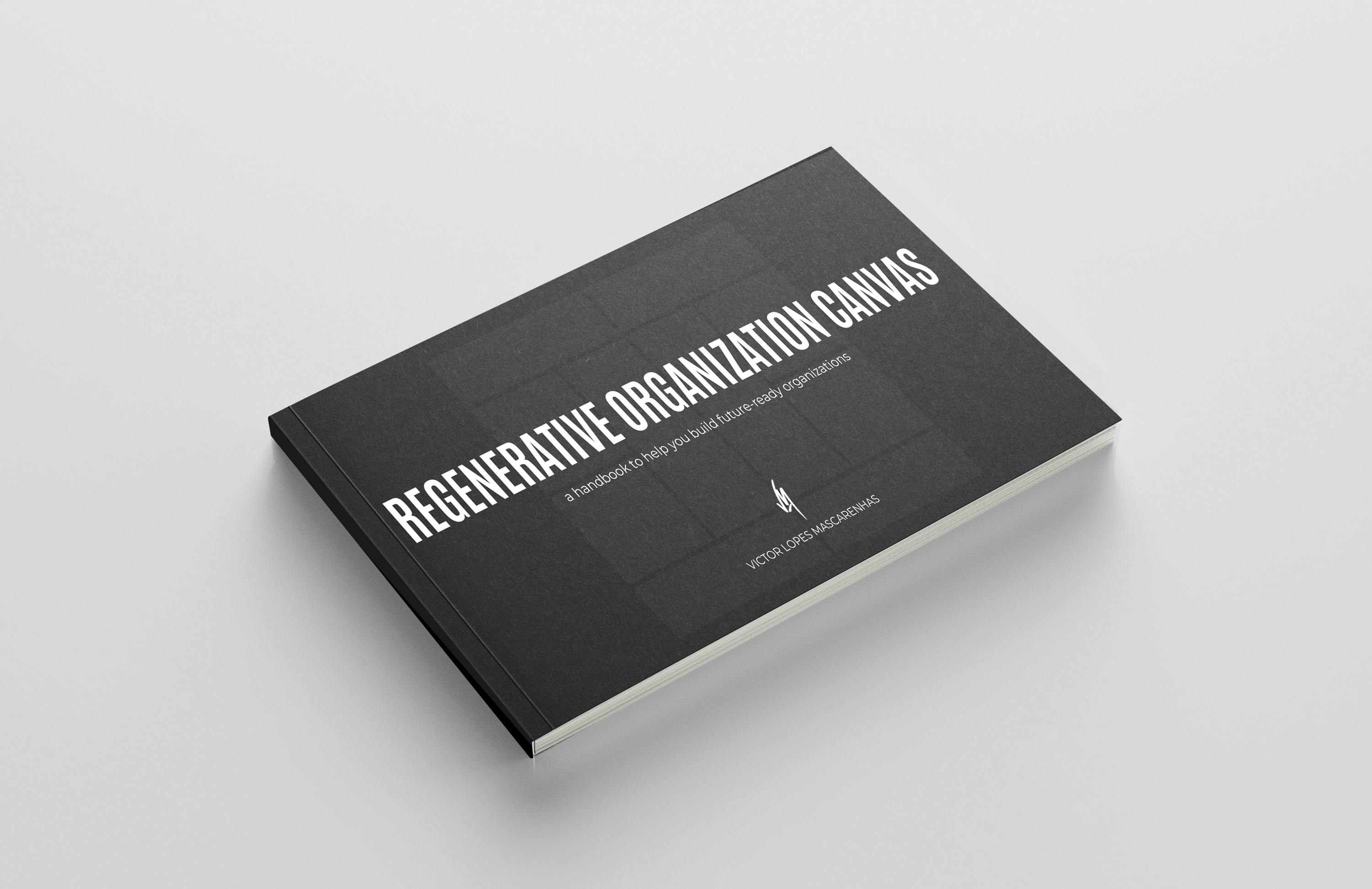
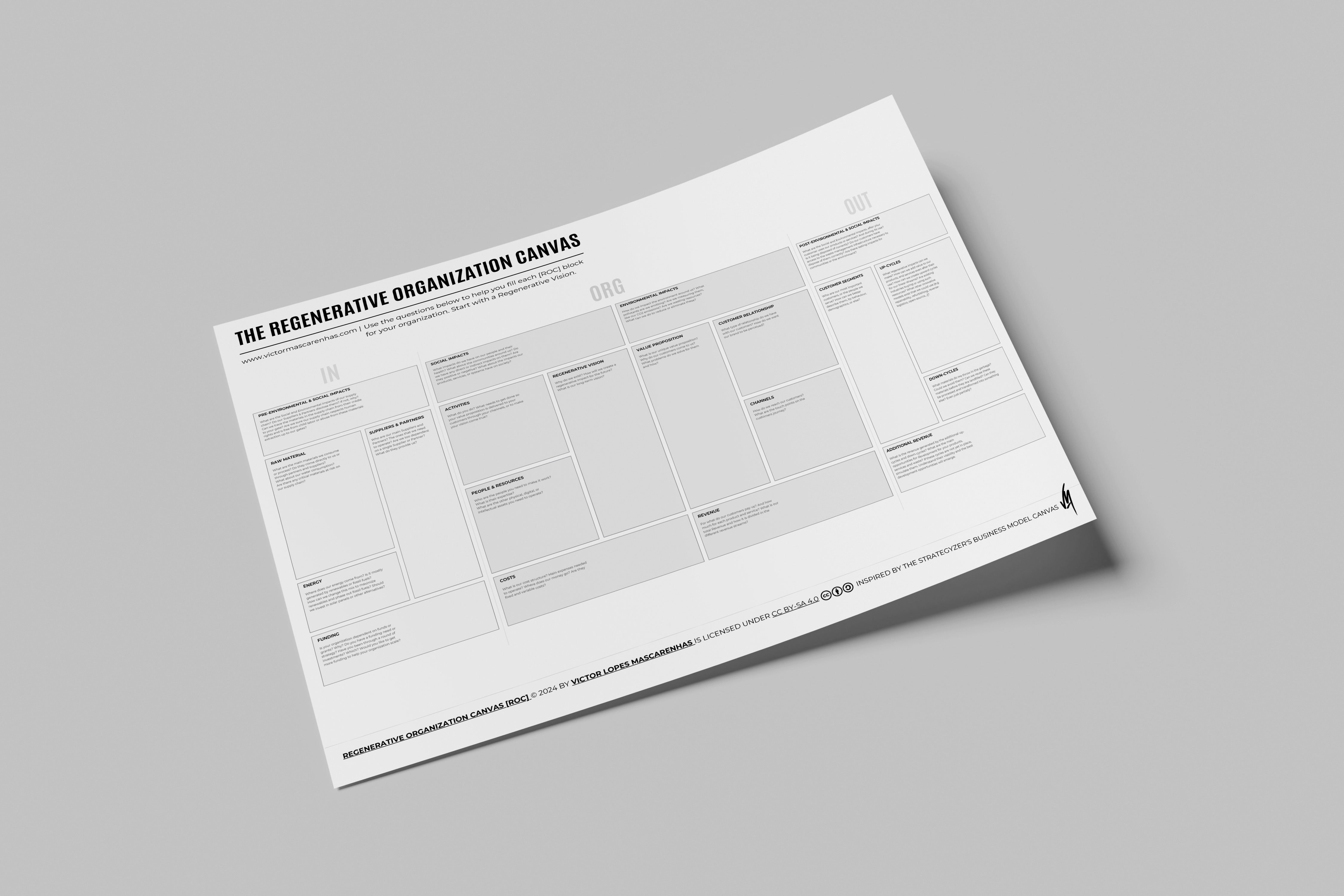
![Regenerative-Organization-Canvas-[ROC]-(C)-2024-by-Victor-Lopes-Mascarenhas-is-licensed-under-CC-BY-SA-4.0.png Regenerative-Organization-Canvas-[ROC]-(C)-2024-by-Victor-Lopes-Mascarenhas-is-licensed-under-CC-BY-SA-4.0.png](/system/files/webform/champions/18921/Regenerative-Organization-Canvas-%5BROC%5D-%28C%29-2024-by-Victor-Lopes-Mascarenhas-is-licensed-under-CC-BY-SA-4.0.png)
